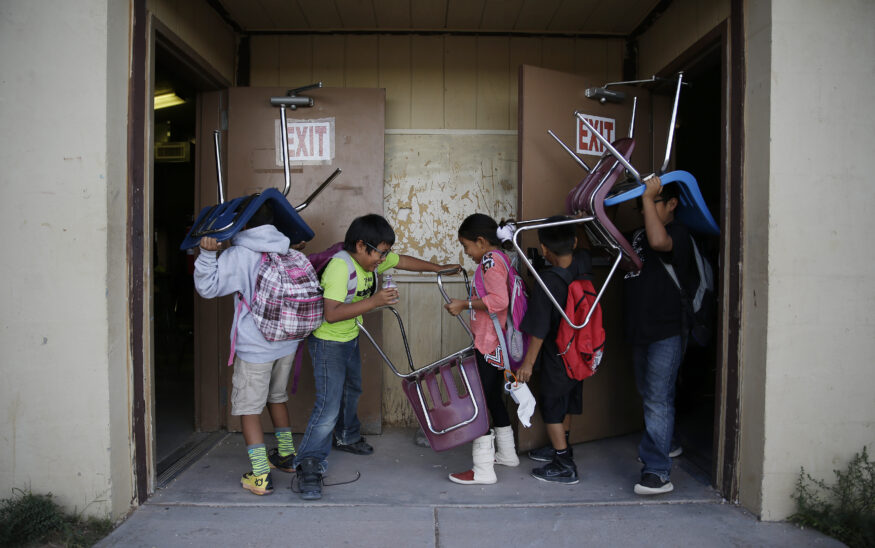Tribal schools lose federal Impact Aid amid government shutdown
Ellis Preston, Arizona Capitol Times//October 12, 2025//
Tribal schools lose federal Impact Aid amid government shutdown
Ellis Preston, Arizona Capitol Times//October 12, 2025//
Key Points:
-
The government shutdown has included the pause of the Impact Aid Program
-
Program fills the gap in tax funding for schools located on federal lands
-
Schools forced to pause certain spending initiatives to accommodate
As the government shutdown continues, federal money originally allocated for school districts on tribal lands has been paused, affecting several Arizona districts.
Started in 1950, the Impact Aid Program compensates school districts located on federal land, such as Indigenous reservations and military bases, making up for their lack of property taxes.
For the 2025 fiscal year, $1.625 billion was allocated for Impact Aid across the United States, according to a report from the National Association of Federally Impacted Schools.
According to an Impact Aid overview from the Department of Education, schools use impact aid for teacher salaries, special enrichment programs and additional payments for children with disabilities.
The federal government officially shut down on the night of Sept. 30, due to contention surrounding the 2026 fiscal year budget. The last government shutdown began in 2018 and lasted 35 days from December into January.
According to a statement released by the Impact Aid Grant System on Oct. 1, no Impact Aid payments will be made while the government is shutdown. Additionally, the IAGS’s staff will be unavailable and cannot be reached throughout the shutdown. After the government resumes and the 2026 budget is finalized, Impact Aid payments will be expedited, the statement said.
“The Impact Aid Program has been a lifeline for Arizona schools on military bases, tribal lands, and other areas that lose out on local tax revenue,” said Senator Mark Kelly, R-Ariz., in a press release from Sept. 30, the 75th anniversary of the program. “This program helps make sure those schools have the resources to hire teachers, keep class sizes down, and give every student a shot at success.”
Brent Gish, the executive director of the National Indian Impacted Schools Association, said the Impact Aid program is forward funded, meaning the districts receive the money in the year it is appropriated. With that structure, if the money is cut short, schools may not have reserves to fall back on.
“(Impacted schools) are many times forced to go out and take out loans in order to meet payroll or general operational kinds of activities,” Gish said.
According to the National Association of Federally Impacted Schools, Arizona schools receive the highest number of Impact Aid payments in the country, with their 2025 total payment being just over $215.7 million to 59 recipient school districts.
Some of the schools that receive Impact Aid in Arizona are Chinle Unified School District and Kayenta Unified School District.
Chinle Unified School District receives the largest amount of funding in Arizona, with Impact Aid making up about half of their yearly budget. According to Chinle Superintendent Quincy Natay, the pause in payments has become critical.
“We’re not purchasing, we’re minimizing transactions and really evaluating what we can and can’t do with certain purchases,” Natay said.
Natay said that in the coming weeks, he expects an Impact Aid payment of about $14 million, which is half of what the district typically receives in a fiscal year.
“All of the Impact Aid district recipients rely heavily on those dollars,” Natay said. “It does make a difference in the quality of education that we provide here in Chinle and across all impacted districts.”
Despite the loss of a significant amount of money for Chinle Unified, Natay said they will continue to prioritize the students’ experience in the classroom, with the intention of the students never noticing the pause in funds.
Lemual Adson, superintendent of the Kayenta School District, said they have already had to start planning how to budget due to the lack of Impact Aid payments.
“We’re just being extra careful. We’re slowing down pretty much,” Adson said. “If it gets worse, then we’re gonna really stop procurement.”
Adson said about 40% of the district’s total funding comes from what they receive in Impact Aid. He said the school typically gets 50% of the yearly payment up front at the beginning of the year — about $7.5 million — and then receives the second half of the money in smaller installments.
He said the district puts the money to “practically everything,” such as teacher salaries, teacher housing, maintenance costs and the school board budget.
Kayenta uses a reserve fund for emergencies, which Adson said he expects should assist them throughout the government shutdown. If the shutdown lasts longer than expected — about one month — then Adson said they will have to cut costs more significantly and be critical of any money they do spend.
Adson said, due to the news, he had to pause repairs on the district’s kitchen, in order to prioritize more pressing projects.
“It’s going to be a high priority, high need expenditure,” Adson said. “We’re not going to do anything frivolous. We’re just going to make sure people get paid, kids are in school getting fed, teachers are paid.”
When it comes to communication from the federal government, Natay said it has been minimal, with the majority of the Impact Aid offices furloughed.
Gish said he hopes the federal government can recognize its obligation to compensate for federal land, as it is losing tax revenue in a system put in place by the government itself.
He anticipates that some Impact Aid schools from across the country may have to close their doors if the shutdown continues.
“This needs to be resolved as quickly as possible so it doesn’t result in basically laying people off and canceling programs,” Gish said.
Like Adson and Gish, Natay said he, too, fears that if the government shutdown surpasses the last shutdown of 35 days, his district may struggle to sustain its normal operations.
“We rely heavily on those funds,” Natay said. “For my district, about half of our operating budget is from Impact Aid proceeds, and without them, we’re not able to do a lot of the day-to-day quality programs that we offer here at Chile Unified.”














































